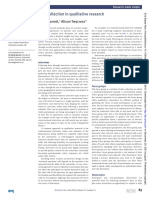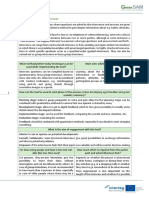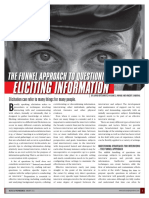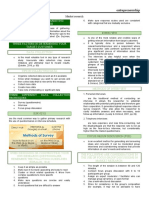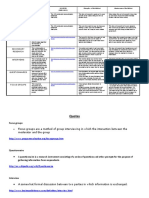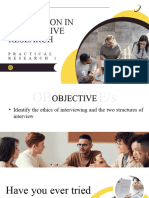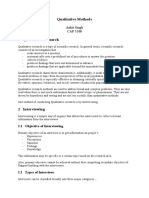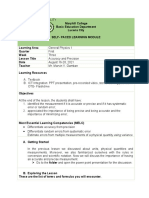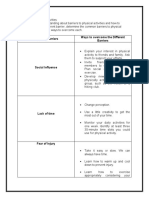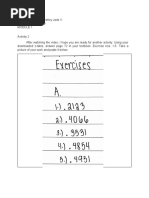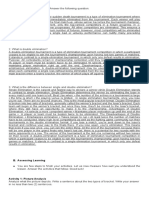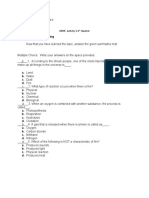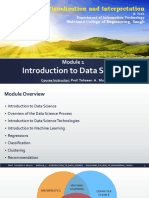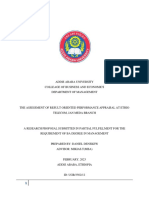0 ratings0% found this document useful (0 votes)
564 viewsAssessing Learning (Activity 2) - MODULE 2
1. Individual interviews, group interviews, and observation were identified as data collection methods.
2. Individual interviews involve one interviewer speaking with one respondent for 30 minutes to an hour to understand their attitudes, beliefs, and experiences. Group interviews involve interviewing several respondents simultaneously, usually 6-10 people.
3. Observation allows researchers to passively collect data on natural behavior or phenomena as it occurs without directly interacting with participants.
Uploaded by
Ashley Jade DomalantaCopyright
© © All Rights Reserved
Available Formats
Download as DOCX, PDF, TXT or read online on Scribd
0 ratings0% found this document useful (0 votes)
564 viewsAssessing Learning (Activity 2) - MODULE 2
1. Individual interviews, group interviews, and observation were identified as data collection methods.
2. Individual interviews involve one interviewer speaking with one respondent for 30 minutes to an hour to understand their attitudes, beliefs, and experiences. Group interviews involve interviewing several respondents simultaneously, usually 6-10 people.
3. Observation allows researchers to passively collect data on natural behavior or phenomena as it occurs without directly interacting with participants.
Uploaded by
Ashley Jade DomalantaCopyright
© © All Rights Reserved
Available Formats
Download as DOCX, PDF, TXT or read online on Scribd
You are on page 1/ 7
Name: Domalanta, Ashley Jade V.
Date: August 17, 2021
Grade & Section: 12-Charity
ASSESSING LEARNING: Activity 2
Complete the table by providing required information.
Other important
Data Collection information (write at least
Tool Used
Method 2)
1. Individual Interview Interviews are In individual interviews, an
conversations that are interviewer talks with one
designed to obtain specific user for 30 minutes to an
kinds of information. Data hour. Individual interviews
obtained from the interviews allow you to probe their
may be recorded on attitudes, beliefs, desires,
audiotapes or videotapes and experiences to get a
with the permission of the deeper understanding of the
respondents. The types of users who come to your
interview: 1. Structured site. You can also ask them
interview-This can be the to rate or rank choices for
form of normal site content. These
conversations or a interviews can take place
freewheeling exchange of face-to-face, by phone or
ideas. The researcher must video conference, or via
be skilled in steering the instant messaging system.
course of the interview. The Individual Interview Is a face
interviewer must be to face two way
knowledgeable on the communication between the
subject or topic of concern. interviewer and the
2. Unstructured interview- respondents. Generally the
The interviewer does not personal interview is carried
ask questions that are not out in a planned manner
part of the questionnaire but and is referred to as a
he or she asks the ‘structured interview’. This
interviewee to clarify his or can be done in many forms
her answers. The conduct of e.g. door to door or as a
questioning follows a planned formal executive
particular progression and meeting.
has a well-defined content.
3. semi-structured-There is
a specific set of questions,
but there are also additional
probes that may come in the
form of follow-up questions
that are not included in the
list of the original questions.
Through this process, the
researcher can gather
additional data from a
respondent that may add
depth and significance to
the findings. The instrument
often used in this method is
the interview schedule.
Although interviews are
often dynamic, it is very
difficult to get different
interviews with different
people to follow exactly the
same flow. Researchers can
use interview schedules to
ensure that the interview
stays on track, and even to
give their interview the
desired amount of structure.
A camcorder is used for
collecting data through
interviews. It provides a
combination of both an
audio recorder and a video
camera. The data provided
is qualitative in nature and
allows the respondents to
answer questions asked
exhaustively.
2. Group Interview
Researchers conducting These are interviews
group interviews often use conducted with several
instruments called topic respondents simultaneously
guides, which resemble —ideally six to ten people.
interview schedules, but are This method may be used
less restrictive in structure when a certain effect is
to allow the respondents a desired, or if a topic calls for
more free and dynamic it. It is not uncommon to
exchange of ideas. have two researchers
moderating a group
interview—one to facilitate
the discussion, and the
other to take notes, handle
logistics, and the like. With
permission from all the
respondents, a group
interview may also be
documented via a video or
audio recording device. It is
not uncommon to have two
researchers moderating a
group interview—one to
facilitate the discussion, and
the other to take notes,
handle logistics, and the
like. With permission from
all the respondents, a group
interview may also be
documented via a video or
audio recording device.
Group interviews can be
classified into two types: 1.
Focus group-participants
are selected by the
researcher according to a
specific sampling criteria
(e.g., licensed
dermatologists who have
been practicing for at least
ten years; current college
students majoring in English
who are vying for honors.)
2. Natural group- the
participants belong to a
group that exists
independently of the study
(e.g., all members of the
marketing department of a
certain company, members
of a local sports team)
3. Observation
The instrument often used Observation method
in conjunction with this enables the researcher to
method is called an conduct research in an
observational checklist immersive manner,
(quantitative in nature; make collecting data on natural
use of ratings or numerical phenomena or behavior as
rankings) or observation it occurs. The act of
guide (more qualitative, passively observing an
allow for more general, employee perform their job
descriptive documentation). in order to gain insight into
the demands and subtleties
of the position or the way in
which the individual carries
out their job function and
responds to stresses and
demands. A well-known
example of the observation
interview is of stand
inspections in schools,
where teachers are
observed by an off stand
representative and the
school given an overall
mark based on the findings
of these interviews. Hiding
the observation, known as
unobtrusive observation,
may solve this, but can be
legally shaky. Another form
of observation is time
allocation (TA), which
attempts to observe
someone in a particular time
and place before they know
they are being observed.
There are two types of
observation: 1. Structured.
The researcher utilizes a
checklist as a data
collection tool wherein
expected behavior of
interest has been specified.
2. Unstructured. This is
performed by the researcher
as he or she tries to explain
events without any
preconceived ideas about
what will be observed.
4. Questionnaire The questionnaire is the Surveys or questionnaires
main instrument for are a list of planned, written
collecting data in survey questions about a particular
research. Basically, it is a topic, with spaces provided
set of standardized for the response to each
questions, often called question, intended to be
items, which follow a fixed answered by a number of
scheme in order to collect persons. Surveys and
individual data about one or questionnaires: These are
more specific topics. There designed to collect and
are two types of survey or record information from
questionnaire: 1. Structured. many people, groups or
If possible answers are organisations in a consistent
provided and respondents way. A questionnaire is a
just have to select from form containing questions. It
them. It is generally used for may be a printed form or
quantitative research. 2. one designed to be filled in
Unstructured. If the online. Questionnaires may
questions are open-ended— be administered in many
no options are provided and different ways. A survey, by
the respondents are free to contrast, is normally a large,
answer however they wish. formal exercise. It typically
It is generally used for consists of three different
qualitative research. There aspects: an approved
are two forms of sampling method designed
questionnaire: 1. Closed to ensure the survey is
Form-It has a fixed number representative of a wider
of questions and a limited population; a standard
choice of answers. The questionnaire that ensures
respondents should choose information is collected and
one or more suitable recorded consistently; and a
answers. 2. Open Form-It set of analysis methods that
consists of a number of allow results and findings to
questions. The answers are be generated.
in the form of an essay and
the content may vary
depending on the
respondents. There are
types of questions: 1. Yes or
no. Items are answerable by
yes or no. 2. Recognition.
Fixed alternative answers
are already provided, the
respondents simply choose
from among the given
choices. It contains close-
ended questions. 3.
Completion type. The
respondents are asked to fill
in the blanks with the
necessary information.
Questions are open ended.
5. Subjective type: The
respondents are free to give
their opinion about an issue
or concern. The tools used
in the questionnaire are:
Likert Scale and Semantic
Differential Scale. With the
Likert scale, people state
how much they agree or
disagree with a particular
statement; with the
semantic differential scale,
people filling in the
questionnaire decide how
much of a trait or quality the
item has. A Likert scale
measures agreement or
disagreement to a particular
statement. The scale ranges
from “strongly agree” to
“disagree” with neutral in the
center. You can easily
quantify the results. It’s
usual for the highest
agreement to be rated a 5,
neutral as 3 and the lowest
agreement or no
agreement. This makes it
easy to compare results. On
the other hand, the
Semantic scale is very
subjective on the user’s
part. Plus, there’s no
“neutral” answer, which
makes it difficult to quantify.
You can’t pinpoint direct
metrics with this type of
scale. For example, you
couldn’t find out if “on hold
wait times are less than five
minutes.” You can only ask
how the respondent feels
about wait times
(acceptable/not acceptable).
A potential benefit of the
semantic differential scale is
that the user is really only
posed with two options that
are opposites, where the
Likert scale has a range of
intensities to choose from.
You might also like
- Seong K. Mun, Sonja Dieterich - Artificial Intelligence in Radiation Oncology-World Scientific Publishing (2023)100% (1)Seong K. Mun, Sonja Dieterich - Artificial Intelligence in Radiation Oncology-World Scientific Publishing (2023)393 pages
- Journal of Retailing and Consumer Services: Mengmeng Song, Xinyu Xing, Yucong Duan, Jason Cohen, Jian MouNo ratings yetJournal of Retailing and Consumer Services: Mengmeng Song, Xinyu Xing, Yucong Duan, Jason Cohen, Jian Mou17 pages
- R A & F Data Collection Methods S - : It Has Predetermined Questions, ButNo ratings yetR A & F Data Collection Methods S - : It Has Predetermined Questions, But8 pages
- Data Collection in Qualitative Research: David Barrett, Alison TwycrossNo ratings yetData Collection in Qualitative Research: David Barrett, Alison Twycross2 pages
- Eca Audit Interview Guideline en Oct2013No ratings yetEca Audit Interview Guideline en Oct201311 pages
- Introduction To Online Qualitative ResearchNo ratings yetIntroduction To Online Qualitative Research28 pages
- Barrett & Twycross (2018) Data Collection in Qualitative ResearchNo ratings yetBarrett & Twycross (2018) Data Collection in Qualitative Research2 pages
- Lesson 11: In-Depth Interview - Conversational:: 1. ThematizingNo ratings yetLesson 11: In-Depth Interview - Conversational:: 1. Thematizing6 pages
- LESSON 11 Preparing and Implementing Research InstrumentNo ratings yetLESSON 11 Preparing and Implementing Research Instrument22 pages
- LESSON-2.1.2_Data-Collection-for-Quali-ResearchNo ratings yetLESSON-2.1.2_Data-Collection-for-Quali-Research4 pages
- Compare The Types of Interview, at A GlanceNo ratings yetCompare The Types of Interview, at A Glance3 pages
- Specific Monitoring Methods: Direct Observation Surveys/Interviews Focus Group Discussions (FGD) Pile-Ranking ExercisesNo ratings yetSpecific Monitoring Methods: Direct Observation Surveys/Interviews Focus Group Discussions (FGD) Pile-Ranking Exercises4 pages
- Society Culture Notes - Social Continuity and ChangeNo ratings yetSociety Culture Notes - Social Continuity and Change12 pages
- W12 Ways On How To Systematically Collect Data PDFNo ratings yetW12 Ways On How To Systematically Collect Data PDF7 pages
- Lesson 3 - Data Collection and Analysis ProcedureNo ratings yetLesson 3 - Data Collection and Analysis Procedure23 pages
- Types of Research Methods:: Applied Research Fundamental ResearchNo ratings yetTypes of Research Methods:: Applied Research Fundamental Research4 pages
- Singhankit - 937548 - 28309801 - Qualitative Methods by Ankit SinghNo ratings yetSinghankit - 937548 - 28309801 - Qualitative Methods by Ankit Singh5 pages
- Group 3 (Preparing and Implementing Research Instrument)No ratings yetGroup 3 (Preparing and Implementing Research Instrument)28 pages
- Construction of Tool For Data Collection Interview SheduleNo ratings yetConstruction of Tool For Data Collection Interview Shedule14 pages
- Tab I - Conducting Key Informant Interview - USAIDNo ratings yetTab I - Conducting Key Informant Interview - USAID6 pages
- Research Methods and Methods in Context Revision Notes for AS Level and A Level Sociology, AQA FocusFrom EverandResearch Methods and Methods in Context Revision Notes for AS Level and A Level Sociology, AQA FocusNo ratings yet
- In Your Own Words, Compare and Contrast Qualitative and Quantitative ResearchNo ratings yetIn Your Own Words, Compare and Contrast Qualitative and Quantitative Research3 pages
- Assessing Learning (Activity 2) - MODULE 2No ratings yetAssessing Learning (Activity 2) - MODULE 21 page
- Activity 3 - Domalanta, Ashley Jade v. (12-Charity)No ratings yetActivity 3 - Domalanta, Ashley Jade v. (12-Charity)1 page
- Assessing Learning 2 - Domalanta, Ashley Jade V. (12-Charity)No ratings yetAssessing Learning 2 - Domalanta, Ashley Jade V. (12-Charity)2 pages
- Activity 1 and 2 - Domalanta, Ashley Jade V. (12-Charity)No ratings yetActivity 1 and 2 - Domalanta, Ashley Jade V. (12-Charity)2 pages
- Common Barriers Ways To Overcome The Different BarriersNo ratings yetCommon Barriers Ways To Overcome The Different Barriers2 pages
- Ashley Jade Domalanta - HG G11 Q1 Mod3 ASNo ratings yetAshley Jade Domalanta - HG G11 Q1 Mod3 AS6 pages
- Assessing Learning - Domalanta, Ashley Jade V. (12-Charity)No ratings yetAssessing Learning - Domalanta, Ashley Jade V. (12-Charity)3 pages
- Ashley Jade Domalanta - SPLM2-2Q-GENBIO2No ratings yetAshley Jade Domalanta - SPLM2-2Q-GENBIO24 pages
- Assessing-Domalanta, Ashley Jade V. (12-Charity)No ratings yetAssessing-Domalanta, Ashley Jade V. (12-Charity)4 pages
- Self-Paced Learning Module: V L33RvphetikNo ratings yetSelf-Paced Learning Module: V L33Rvphetik7 pages
- Ashley Jade Domalanta - PEH 11 ACTIVITIES 50 PtsNo ratings yetAshley Jade Domalanta - PEH 11 ACTIVITIES 50 Pts3 pages
- Recognize Dimensions of Technology That Are Enabling Through Graphic Web0% (1)Recognize Dimensions of Technology That Are Enabling Through Graphic Web4 pages
- Social Research Update 2 - Using Diaries in Social ResearchNo ratings yetSocial Research Update 2 - Using Diaries in Social Research4 pages
- Polytechnic Classes: Civil Engineering DepartmentNo ratings yetPolytechnic Classes: Civil Engineering Department12 pages
- Topic 8 Lesson - Legal Research MethodsNo ratings yetTopic 8 Lesson - Legal Research Methods32 pages
- CertificateOfCompletion - A Design Thinking Approach To Putting The Customer First-MergedNo ratings yetCertificateOfCompletion - A Design Thinking Approach To Putting The Customer First-Merged31 pages
- Introduction To Research in ArchitectureNo ratings yetIntroduction To Research in Architecture49 pages
- Ogbeibu Gaskin 2022 Back From The Future Mediation and Prediction of Events Uncertainty Through Event Driven Models EdmsNo ratings yetOgbeibu Gaskin 2022 Back From The Future Mediation and Prediction of Events Uncertainty Through Event Driven Models Edms10 pages
- Theories of Second Language Acquisition: Assessment/ EvaluationNo ratings yetTheories of Second Language Acquisition: Assessment/ Evaluation2 pages
- Chapter 5 Environmental Management (Autosaved)No ratings yetChapter 5 Environmental Management (Autosaved)7 pages
- Focus1 2E End of Year Test Writing ANSWERS PDFNo ratings yetFocus1 2E End of Year Test Writing ANSWERS PDF2 pages
- Seong K. Mun, Sonja Dieterich - Artificial Intelligence in Radiation Oncology-World Scientific Publishing (2023)Seong K. Mun, Sonja Dieterich - Artificial Intelligence in Radiation Oncology-World Scientific Publishing (2023)
- Journal of Retailing and Consumer Services: Mengmeng Song, Xinyu Xing, Yucong Duan, Jason Cohen, Jian MouJournal of Retailing and Consumer Services: Mengmeng Song, Xinyu Xing, Yucong Duan, Jason Cohen, Jian Mou
- R A & F Data Collection Methods S - : It Has Predetermined Questions, ButR A & F Data Collection Methods S - : It Has Predetermined Questions, But
- Data Collection in Qualitative Research: David Barrett, Alison TwycrossData Collection in Qualitative Research: David Barrett, Alison Twycross
- Barrett & Twycross (2018) Data Collection in Qualitative ResearchBarrett & Twycross (2018) Data Collection in Qualitative Research
- Lesson 11: In-Depth Interview - Conversational:: 1. ThematizingLesson 11: In-Depth Interview - Conversational:: 1. Thematizing
- LESSON 11 Preparing and Implementing Research InstrumentLESSON 11 Preparing and Implementing Research Instrument
- Specific Monitoring Methods: Direct Observation Surveys/Interviews Focus Group Discussions (FGD) Pile-Ranking ExercisesSpecific Monitoring Methods: Direct Observation Surveys/Interviews Focus Group Discussions (FGD) Pile-Ranking Exercises
- Society Culture Notes - Social Continuity and ChangeSociety Culture Notes - Social Continuity and Change
- W12 Ways On How To Systematically Collect Data PDFW12 Ways On How To Systematically Collect Data PDF
- Types of Research Methods:: Applied Research Fundamental ResearchTypes of Research Methods:: Applied Research Fundamental Research
- Singhankit - 937548 - 28309801 - Qualitative Methods by Ankit SinghSinghankit - 937548 - 28309801 - Qualitative Methods by Ankit Singh
- Group 3 (Preparing and Implementing Research Instrument)Group 3 (Preparing and Implementing Research Instrument)
- Construction of Tool For Data Collection Interview SheduleConstruction of Tool For Data Collection Interview Shedule
- Tab I - Conducting Key Informant Interview - USAIDTab I - Conducting Key Informant Interview - USAID
- Research Methods and Methods in Context Revision Notes for AS Level and A Level Sociology, AQA FocusFrom EverandResearch Methods and Methods in Context Revision Notes for AS Level and A Level Sociology, AQA Focus
- In Your Own Words, Compare and Contrast Qualitative and Quantitative ResearchIn Your Own Words, Compare and Contrast Qualitative and Quantitative Research
- Activity 3 - Domalanta, Ashley Jade v. (12-Charity)Activity 3 - Domalanta, Ashley Jade v. (12-Charity)
- Assessing Learning 2 - Domalanta, Ashley Jade V. (12-Charity)Assessing Learning 2 - Domalanta, Ashley Jade V. (12-Charity)
- Activity 1 and 2 - Domalanta, Ashley Jade V. (12-Charity)Activity 1 and 2 - Domalanta, Ashley Jade V. (12-Charity)
- Common Barriers Ways To Overcome The Different BarriersCommon Barriers Ways To Overcome The Different Barriers
- Assessing Learning - Domalanta, Ashley Jade V. (12-Charity)Assessing Learning - Domalanta, Ashley Jade V. (12-Charity)
- Recognize Dimensions of Technology That Are Enabling Through Graphic WebRecognize Dimensions of Technology That Are Enabling Through Graphic Web
- Social Research Update 2 - Using Diaries in Social ResearchSocial Research Update 2 - Using Diaries in Social Research
- CertificateOfCompletion - A Design Thinking Approach To Putting The Customer First-MergedCertificateOfCompletion - A Design Thinking Approach To Putting The Customer First-Merged
- Ogbeibu Gaskin 2022 Back From The Future Mediation and Prediction of Events Uncertainty Through Event Driven Models EdmsOgbeibu Gaskin 2022 Back From The Future Mediation and Prediction of Events Uncertainty Through Event Driven Models Edms
- Theories of Second Language Acquisition: Assessment/ EvaluationTheories of Second Language Acquisition: Assessment/ Evaluation








